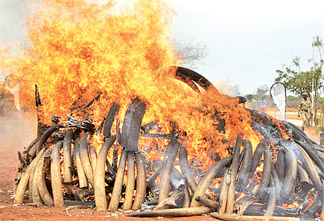Ivory demand sends poaching to record levels
Selling the tusks from a single large male elephant can earn a
local poacher the equivalent of 15 years' wages
By Steve Connor
Elephant poaching in one of the world's most famous wildlife reserves
has reached record levels, to satisfy the growing demand for ivory
destined for traders in China, according to a group of elephant experts.
 The highest poaching rates ever seen in Kenya's Samburu National
Reserve were recorded in the first five months of this year. The number
of elephants killed in the past two and half years has exceeded the
total for the previous 11, according to the experts. The highest poaching rates ever seen in Kenya's Samburu National
Reserve were recorded in the first five months of this year. The number
of elephants killed in the past two and half years has exceeded the
total for the previous 11, according to the experts.
Samburu elephants are probably the most studied population in the
world, yet this high level of scientific interest has not protected them
from poachers who can earn a fortune from selling the ivory tusks of
mature males, and even females.
George Wittemyer, of Colorado State University, and David Daballen
and Iain Douglas-Hamilton, of Save the Elephants in Nairobi, say in
joint letter to the journal Nature that there has recently been a
distressing surge in ivory poaching, which has coincided an illegal
trade in ivory.
"This ivory is mainly destined for China. Effective protection of
elephants depends partly on more conservation investment, but mainly on
stemming the demand for ivory and eliminating black-market trade actions
that mandate leadership from and co-operation with China," they say. The
selective poaching of bull elephants for their valuable tusks has led to
a population with double the usual number of females. The ivory tusks of
the biggest males can be sold for a price equivalent to 15 years' salary
for a local unskilled labourer.
But even adult females, with their relatively smaller tusks, are now
being targeted, the experts say.
About one in every five groups of elephants which have a matriarchal
society are without any mature females, while the number of orphans in
the Samburu reserve has increased rapidly.
"These changes correlate with a near tripling of the total number of
seizures of illegal ivory in or coming from Kenya and with rising ivory
prices. Local blackmarket prices around Samburu have more than doubled
since 2007, and are an order of magnitude greater than in 1990," the
experts say.
"Ivory demand and prices have reached a point at which poachers are
willing to target well-protected, closely monitored populations. With
many poorly protected, soft-target populations now over-harvested, the
pressure on the Samburu elephant population may be a harbinger of what
is to come for Africa's protected areas."
The Samburu ecosystem of northern Kenya covers some 8,900 square
miles, consisting of a mosaic of cultivated areas and national reserves.
Satellite tracking has shown that some bull elephants in particular
migrate from one region to another along ancient migratory routes, often
taking them through areas now cultivated by an expanding human
population.
Courtesy: The Independent
|

